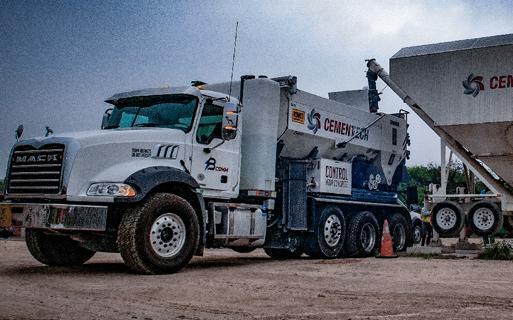





“The







“The
Amkor Technology Inc., a provider of semiconductor packaging and test services, announced on Oct. 6, 2025, the groundbreaking and expanded planned investment of its new outsourced semiconductor advanced packaging and test campus near Peoria, Ariz.
The expanded investment includes additional cleanroom space and a second greenfield packaging and test facility, increasing total project investment by more than $5 billion to a total of $7 billion across two phases. A contractor was not named.
The groundbreaking ceremony brought together government officials, industry leaders and community stakeholders to celebrate the milestone. Amkor’s investment supports the broader strategy to strengthen United States semiconductor leadership and will be the first U.S.-based high-volume advanced packaging facility.
Upon completion of both phases, the campus will offer more than 750,000-sq.-ft. of cleanroom space and as many as 3,000 high-quality jobs.
Construction of the first manufacturing facility on the campus is expected to be completed in mid-2027, with production beginning in early 2028. The new greenfield facilities will serve as a cornerstone of America’s advanced packaging capabilities, supporting key customers including Apple and NVIDIA. Amkor’s expanded investment is supported by the Trump administration’s CHIPS for America Program, the Advanced Manufacturing Investment Tax Credit and state and local governments.
see AMKOR page 6







Salt Lake’s downtown is expanding west with The Power District, Larry H. Miller Real Estate’s 100plus-acre mixed-use development and hopeful site of a future MLB stadium.
Community leaders gathered on Oct. 27, 2025, for the groundbreaking on a 10-story, 300,000-sq.-ft. corporate campus for Rocky Mountain Power. The Power District is close to both the downtown core and the Salt Lake City International Airport and also connected to the Jordan River and Utah State Fairpark.
“The Power District is more than a project — it’s our family and organization’s commitment to Salt Lake City and the state of Utah,” said Steve Miller, chairman of the Larry H. Miller Co. “This development will create thousands of jobs, ignite economic growth and serve as the gateway neighborhood to Utah’s Capital City.”

The project is expected to cost $3.5 billion, according to deseret.com
The Power District master plan overview includes:
The first corporate campus at The Power District is being built for Rocky Mountain Power in conjunction with SOM, Architectural Nexus and Okland Construction.
Larry H. Miller Real Estate said it is incorporating sustainable practices and innovative design into The Power District’s master plan. This site features views of the downtown skyline and Wasatch Mountains.
The company said it is working closely with the support of a coalition of community leaders, including state leaders, the Utah State Fairpark, Salt Lake City, the Jordan River Commission and westside leaders, to incorporate several area master plans that have been studied over the years.
• 100-plus-acre shovel-ready site with flexible zoning and building options;
• 1.3 million sq.-ft. office — a corporate campus with connected transportation options, amenities, open space and direct access to the airport and downtown;
• 4,700 housing units — mixture of housing types and price points;
• 320,000 sq. ft. of retail space;
• 300 hotel keys;
• views of the downtown skyline and Wasatch Mountains; a mile of riverfront cleanup and access; trails and green space; and a
see POWER page 3

The Utah Department of Transportation announced on Oct. 20, 2025, the completion of the U.S. 191 Realignment Project north of Vernal — an effort delivered through an innovative public-private partnership with Simplot Phosphates that saved taxpayers approximately $40 million.
A ribbon-cutting ceremony occurred the next day.
The project replaced a 2.6-mi. section of steep switchbacks with a straighter, safer alignment designed to improve travel for trucks, residents and visitors heading to Flaming Gorge.
Key improvements included:
• replacing steep switchbacks with a new alignment and standard horizontal curves;
• adding a northbound climbing lane and a southbound passing lane;
• constructing a new runaway truck ramp; and
• building standard-width shoulders to improve safety and recovery zones.
The project was completed as a public-private partnership with Simplot Phosphates, which provided significant support in moving millions of cu. yds. of earth for the new road embankments worth $40 million. This innovative funding method helped UDOT deliver the project more efficiently and at a lower cost to taxpayers.
“I don’t think you could ask for a better public-private partnership,” said state Sen. Ron Winterton. “It’s a win-win. They can come back and mine where the current road exists, and we get a new, safer road.”

“This truly is a win-win-win,” said Rob Clayton, UDOT Region Three director. “It’s a win for the traveling public, who now have a safer and more efficient road; a win for Simplot, which can continue its operations in the area for decades to come; and a win for UDOT, as our partnership allowed us to deliver the project faster and at a lower cost.”
Simplot leadership described the project as an example of effective coordination between industry and government.
“The realignment of U.S. 191 north of Vernal represents a milestone in infrastructure collaboration between the public sector and a private entity that benefits both community and industry,” said G. Rey Reinhardt, Simplot AgriBusiness president. “We’re proud to be part of a solution that strengthens Utah’s rural connectivity and long-term growth.”

The American Rental Association (ARA) Foundation and The Toro Co. Foundation donated equipment, volunteers and a $20,000 grant to enhance the Tennessee Avenue Greenway with new trees, a pollinator garden and thousands of plants on Sept. 17, 2025.
Collaborators from The Toro Co., Ditch Witch, Ditch Witch of the Rockies, Denver Park Trust, Denver Parks and Recreation, Arvada Rent-Alls, All Purpose Rental & Sales, Aspen Rent-All, Bighorn Rents, Butler Rents, LL Johnson, Alert Rental Software and Continental Divide Marketing joined the effort.
The Tennessee Avenue Greenway is an area between the Westwood Via Verde and the Athmar Park neighborhood. The project is transforming historically unused space along a power line easement into a safe, green, culturally engaging area where residents can live a healthy, active lifestyle.
“This has been a project that has been a long time coming for the community. It took the support of partners like the ARA Foundation and Toro to get it done today,” said Jolon Clark, executive director of Denver Parks and Recreation. “They have taken something that was an eyesore and made it a beautiful space that residents can enjoy.”
On the day of the project, 27 volunteers transformed portions of the greenway by creating a pollinator garden containing more than 1,000 flowers and shrubs, added nine trees and spread mulch across more than 2,000 sq. ft. The newly installed fruit-bearing trees introduced a food forest to provide fresh produce for the neighborhood and long-term canopy and shade.
“I just want to thank you all for your contribution today” said Flor Alvidrez, Denver city councilwoman for District 7. “This is an amazing opportunity to uplift the community, provide food, tree canopy and a beautiful walkable space in a neighborhood surrounded by highways.”

• potential Major League Baseball ballpark.
The Miller family is pursing an expansion baseball team for Salt Lake City, according to deseret.com. A group of state, community and business leaders called Big League Utah is supporting that effort.
The all-electric campus is inspired by the character of the historic Gadsby Power Plant; it translates the district’s industrial past into a modern, efficient and human-centered workplace.
“Rocky Mountain Power’s current facility was originally built in 1951, and we are excited for an updated building with modern technology and modern tools that will allow our dedicated teams to maintain the level of service that our customers expect, while being a part of this vibrant Power District community,” said Dick Garlish, Rocky Mountain Power president.
An investment of $10 million for infrastructure improvements and site cleanup is under way. In collaboration with community partners, The Power District will elevate the
Jordan River and improve it through remediation, enhancement and activation of the river and its banks, improving water quality and restoring native vegetation and fish, providing recreational opportunities in an urban setting.
For details, visit thepowerdistrict.com. (All renderings courtesy of the Larry H, Miller Co.)











































In the competitive world of sand and aggregate processing, up time and efficiency are paramount, and that’s what the team at CDE delivered when it partnered with Granite Construction to install a 550-ton-per-hour (TPH) wash plant in Utah.
Granite’s ambitious timeline meant the plant needed to perform — and fast. So, with hands-on, expert support, CDE’s CustomCare team was involved early in the process to ensure a smooth setup and valuable optimizations to help the plant reach its full capacity sooner rather than later.
The CustomCare team ensured installation and commissioning went smoothly and that production issues were detected early. One of the first challenges: the plant was operating below the expected TPH.
However, using CDE’s SmartTech monitoring platform, dedicated engineers pinpointed variability in the feed material as the cause of performance gap. Without early intervention, enabled by CDE’s proprietary technology, thousands of tons of feed material could have been lost over time.
“CDE technical advisers came in to balance the plant and optimize it,” said Ric Skinner, Granite Construction manager. “Can’t say enough about how excellent they’ve been.”
CDE SmartTech enables customers to understand their plant’s performance, schedule maintenance and easily order parts. It equips operators, managers and owners with realtime data and insights to facilitate informed decision-making that can increase productivity, improve operational efficiency and maximize up-time.
Sensors fitted to a plant provide up to 300 precise data points and continuously stream real-time, in-depth performance reports. Providing a full and transparent overview of the health of a plant, this live feed is accessible 24/7 to customers through a handy mobile app, and CDE also has dedicated staff remotely monitoring OEE data to identify trends, provide proactive maintenance and advise on plant optimization.
“Our focus is helping customers hit their target tons per hour, every hour, every day,” said Andrew Buning, USA CustomCare manager. “It’s about using real-time monitoring and to sustain optimal performance over the long term.”
CustomCare isn’t only about maintenance. It’s also about performance optimization.
In a typical construction and demolition waste recycling plant running 150TPH, CDE estimates an 8 percent dip in throughput over a year. In hard economic terms, that can mean revenue losses of anywhere between $185,000 and $215,000, equivalent to approximately $16,000 per month.
For the Granite plant, the difference has been transformative. With SmartTech’s real-time insights and consistent support from CDE engineers, the facility today not only reaches, but maintains its full capacity.
“The aftercare so far that we’ve seen has been invaluable,” said Stormy Watne, Granite Construction plant manager.
For aggregate producers considering a step up in performance, the message is clear. The right service partnership can translate high capability into high performance.
For more information, visit cdegroup.com.
Construction started on Nov. 6, 2025, at the Velvet-Wood uranium mine in southeastern Utah, according to moabtimes.com.
The project is the first approved under the Interior Department’s accelerated permitting process. That process debuted in response to President Donald Trump’s “national energy emergency.”
Mine owners Canadian-based Anfield Energy plan to resume uranium and vanadium production at the long-idle site near Lisbon Valley in San Juan County.
Uranium can be processed into nuclear reactor fuel, while vanadium is a common component in steel alloys, moabtimes.com reported.
The underground mine is being redeveloped, having last operated in 1984.
Neither project costs nor contractor names were released.
Surface construction and road work have started, with underground operations slated to begin in 2026, pending mine-safety certification, final state approval of its minewater-treatment system and San Juan County permits, according to moabtimes.com.
If the state reauthorizes the facility for operation, Anfield plans to process ore at its Shootaring Canyon Mill near Ticaboo.
At the Nov. 6 groundbreaking, Anfield officials described plans to resume production by mid-2026, describing Velvet-
Wood as the first step in a broader “hub-and-spoke” strategy to restart several former uranium and vanadium mines across Utah and western Colorado, according to moabtimes.com.
“Nov. 6 will be more than a groundbreaking — it’s a bold declaration of Anfield’s readiness to help fuel the American nuclear renaissance,” CEO Corey Dias said in a company statement before the event.
Anfield director Joshua Bleak said the company plans to submit a mine water treatment system plan for state approval within a month. It also must complete Mine Safety and Health Administration certification and obtain county building and septic permits before beginning mining operations.
Anfield expects the mine to employ 40-60 workers, while generating hundreds of millions of dollars in total economic impact over its 10-year life, moabtimes.com reported.
The company estimates that the mine holds approximately 5 million lbs. of uranium and 7 million lbs. of vanadium. Before closing in 1984, the mine produced approximately 4 million lbs. of uranium and 5 million lbs. of vanadium.
“I think the bottom line is we’ve found a way to move these assets forward in a very difficult environment, and now we’re starting to bear fruit,” Dias said. “We’re the best environment that we’ve seen in my 12 years here … we’re excited about being the next uranium producer in the U.S.”
“This groundbreaking represents a bold step in Amkor’s long-term strategy for growth and innovation,” said Giel Rutten, Amkor’s president and CEO. “We’re building a facility to meet our customers’ most advanced needs that will help shape the future of semiconductor manufacturing in the United States. Arizona offers the right
mix of talent, infrastructure and industry presence, and we’re proud to deepen our roots here.”
Strategically located in Arizona’s growing high-tech corridor, the campus will house the most sophisticated outsourced semiconductor packaging and test facilities in the country, according to Amkor.
It will feature smart factory tech-
nologies and scalable production lines to meet evolving market demands for AI, high-performance computing, mobile communications and automotive applications.
The campus will focus on advanced packaging and testing technologies and will complement TSMC’s frontend wafer fabrication for full end-toend semiconductor manufacturing.
































